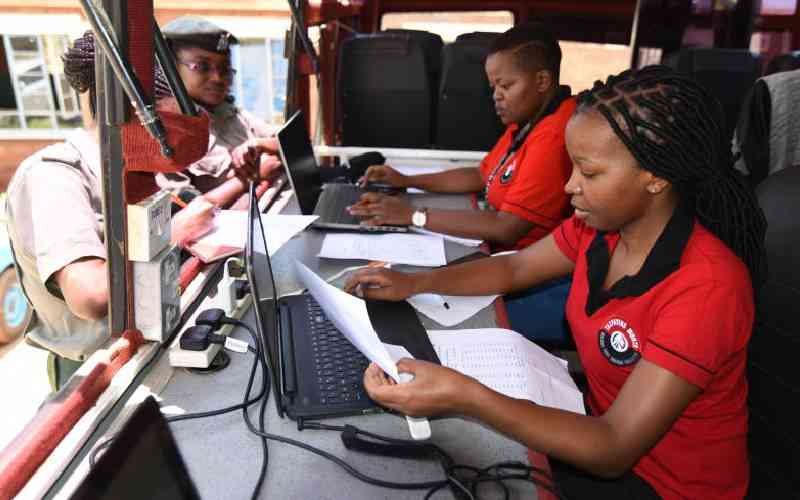That nearly one in five Kenyan teenage girls is a mother represents not only a huge cost to the health sector, but also a betrayal of potential on a shocking scale.
November 20, 2018 marks International Children’s Day. Perhaps a day we should use to reflect on a national crisis of underage pregnancies that confronts us.
Recent media reports of the high number of girls failing to sit their final secondary school examinations (KSCE) only reveal the extent to which we have continued to sweep under the carpet candid discussions about adolescent sexuality.
Education Cabinet Secretary Amina Mohamed said the country must confront this worrying trend.
“We must have this conversation. We cannot bury our heads in the sand. It is happening to our children, our sisters, and even our young brothers. We will deal with it or it will not go away.” No doubt CS Amina has a tough job ahead.
Consider this. Statistics from the United Nations Population Fund (UNFPA) indicate that between June 2016 and July 2017, 378,397 adolescents in Kenya aged 10 to 19 got pregnant.
The carpet’s edges are now too frayed to conceal our failure to act; we no longer can afford the blissful pretence about sexual activity among our teenagers. Nor can the responsibility for decisive solutions be shunted around.
Numerous studies have documented the fact that a high number of teens are already sexually active. These girls are part of the four in ten women in Kenya aged between 15 and 49 who have unintended pregnancies.
There can be no illusions about what they need: accurate, up-to-date information and access to effective contraception.
It is time to take a wholesome picture of the social and economic price society is paying when 15 percent of its teenage girls become pregnant.
For virtually all of them – and statistics say majority are from poor families - it means an end to any dreams of coming out of poverty because they cannot continue with education.
Complications during pregnancy are the second cause of death for 15 to 19-year-old girls, therefore it means their already poor families have additional health care costs to meet.
Children born to such young mothers are more prone to physical and cognitive development.
The overall effect is perpetuation of the cycle of poverty that brings personal catastrophe while weakening social and economic development and adding strain to already stretched medical services.
In reproductive health, as in most things, knowledge is power. But across sub-Saharan Africa too many teenage girls lack knowledge of their bodies, their contraceptive options, and their rights. The notion of rights is central.
Stay informed. Subscribe to our newsletter
As the UNFPA report The Power of Choice states, in countries where rights to health, education and opportunity prevail, fertility rates tend to be lower. Through exercising their wider rights, people exercise choice about the timing and number of their children.
Sex education
The 2014 Kenya Demographic and Health Survey of 2014 that shows girls who have completed secondary education have an average of three children in their lifetimes compared to an average 6.5 for those with no education.
Additionally, around 60 per cent of girls who have completed primary and secondary school use some form of modern contraception compared to only 15% of those with no education.
“The girl child in this country is under threat from all manner of vices, including early pregnancy and female genital mutilation and many other kinds of nonsense that affect our communities. These things have no basis for the development of our country,” said Deputy President William Ruto. The underlying drivers of teenage pregnancy are complex and include gender inequality, child marriage, poverty, sexual violence, and poor education and job opportunities.
To be successful, efforts to reduce the incidence of teenage pregnancy must address all these elements through comprehensive programmes of behaviour change, social and economic development, health and sex education, reproductive rights, and gender equality.
Crucially, such efforts must also include boys and men, whose attitude to girls and women underpin many pervasive social problems in Kenya and across the world.
Reproductive rights and health are also central to achieving the Sustainable Development Goals, particularly Goal 3 on ensuring healthy lives and promoting the well-being for all ages.
As the UN family in Kenya we are working in partnership with government, civil society, religious and youth groups to extend access to sexual and reproductive health information, counselling and services for young people. We intend to step this up.
Three years ago, Kenya launched the Adolescent Sexual and Reproductive Health Policy. Unless bold decisions are made to implement that policy, pregnancies among our youth will continue to be a wrecking ball to the national development agenda particularly the Big Four and the SDGs.
In order for every girl to achieve her full human potential, how can the entire country be engaged to initiate a change in mindset in Kenya? How can a national conversation on this subject be leveraged into national action?
-The writer is the United Nations Resident Coordinator to Kenya
 The Standard Group Plc is a
multi-media organization with investments in media platforms spanning newspaper
print operations, television, radio broadcasting, digital and online services. The
Standard Group is recognized as a leading multi-media house in Kenya with a key
influence in matters of national and international interest.
The Standard Group Plc is a
multi-media organization with investments in media platforms spanning newspaper
print operations, television, radio broadcasting, digital and online services. The
Standard Group is recognized as a leading multi-media house in Kenya with a key
influence in matters of national and international interest.
 The Standard Group Plc is a
multi-media organization with investments in media platforms spanning newspaper
print operations, television, radio broadcasting, digital and online services. The
Standard Group is recognized as a leading multi-media house in Kenya with a key
influence in matters of national and international interest.
The Standard Group Plc is a
multi-media organization with investments in media platforms spanning newspaper
print operations, television, radio broadcasting, digital and online services. The
Standard Group is recognized as a leading multi-media house in Kenya with a key
influence in matters of national and international interest.








